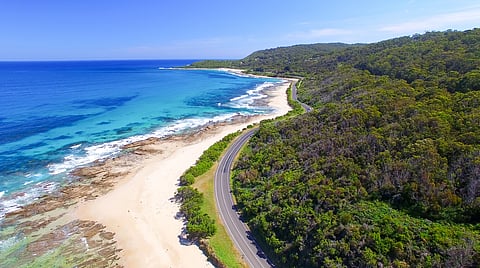

Built in 1932, the Great Ocean Road in the state of Victoria stretches from Torquay to Warnambool across ragged cliffs, wild windswept beaches, tall buffs and tangled rainforests. This popular tourist attraction is an Australian National Heritage site so we decided to check it out.
Our first stop was a delightful little seaside town called Lorne. It's nestled in a nook that protects it from the winds that lash many of the other towns along the drive. In the early October spring of Australia, the ocean was way too cold for a dip, but we walked the length of the beach along the boardwalk and, with few people about, felt like we had the ocean to ourselves.

Lorne is more hip and alternative than some of the other coastal towns that have a more suburban and commercial feel.The café we visited for evening tea had large sofas, mismatched cushions, an eclectic menu and a grungy air; clearly, the operative words here were sink and loll, and that's exactly what we did.
In front of us, a flock of white cockatoos hobbled comically around a lawn, their bodies tilting to one side under the weight of their crests. From the balcony of our bed and breakfast we saw king parrots with blood-red heads and lush green throats, colours so vivid they seemed to belong in a dream.

The next morning was grey, windy and foggy as we drove to Maits Rest, an accessible walking trail in the Great Otway National Park. Although we drove just two hours from Lorne, we felt like we had reached the Amazon basin: a world of eternal green silence where tall trees ruled.
It was quite rewarding to spend an entire day driving from Lorne to Port Fairy, the most scenic and coast-hugging part of the drive. We stopped along the way for short walks, Devonshire tea and other small delights. One such treat was the Cape Otway Lighthouse built in 1848. It's the oldest standing lighthouse on the Australian continent.
The lighthouse still functioned and visitors were allowed to climb to the top of the neat white and red-trim building and take in the view. The wind hits it full tilt and it is impossible to stand outside for more than a minute.
The last major stop of the day was at Port Campbell National Park, better known as the site of the Twelve Apostles. These 12 limestone rocks were eroded into strange shapes by the winds and waves. Only 10 of them currently remain and have to be approached through an interpretive center that boasts a maudlin ode to Australia's immigrant past.
Although these rocks and monuments had impressive shapes, they were after all rocks. There was no possibility of discovering them through our own senses and imagination since they had already been labelled and named. Wandering through them was becoming a bit like checklist tourism rather than a relaxed weekend so we decided to call it a day.
By now we were on top of the cliffs with the ocean well below us. We drove another hour to Port Fairy, the last stop on the Great Ocean Road, before it turns inland to join another highway. Although Port Fairy is not as ethereal as its name, it has the quaint feel of a riverside town of yore.
Lying in an antique four-poster bed in Gobles Mill House, a flour mill converted into a heritage B&B, and ruminating in the wake of a wine-washed dinner of Tasmanian salmon, the only thought that came to my mind was prosaic yet eminently satisfying.
Aaah, this is life.
Air India offers direct flights from New Delhi to Melbourne. However, most flights to Australia require one or two stopovers. Apply for an Australian visa prior to flying there.
